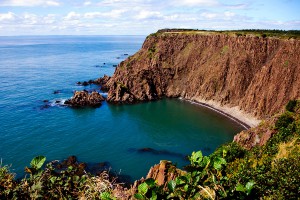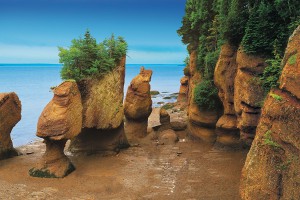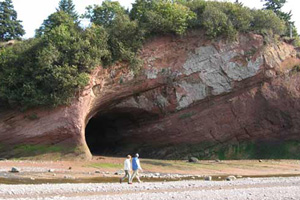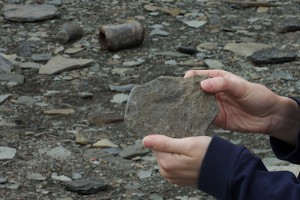As Fundy’s giant tides erode the towering sea cliffs and wash the shores, many interesting rocks, fossils, zeolites and semi-precious stone are revealed. With its fascinating geology dating back hundreds of millions of years, the Bay of Fundy is paradise for geologists.

While combing the beaches at low tides, a trained eye will easily spot such finds as fossils and zeolites. Other discoveries may include amethyst, agate, calcite, coal, copper and jasper and, depending on which section of the Bay of Fundy being explored, one may also discover 200 million year old basalt formations or 350 million year old Carboniferous rock or rocks from the Pre-Cambrian or Devonian periods. These treasures are replenished annually as Fundy’s giant tides beat against and erode the cliffs that line the Bay.
Top 10 Geological Attractions
Here is what Ken Adams, Director/Curator of the Fundy Geological Museum in Parrsboro, NS, lists as the top ten geological attractions specific to the Bay of Fundy region:

- Grand Manan: Jurassic lava flows
- Hopewell Rocks: Tides, Erosion, Glaciation
- Joggins: World-class Carboniferous section, Coal age fossils, World’s oldest reptile fossils
- Cape Chignecto Provincial Park: Plate tectonics, Formation and break up of Pangaea, Glaciation
- Parrsboro Region: Coal age trackways, Triassic-Jurassic volcanics, Sand dunes, Lake beads, Dinosaurs, Glaciation
- Springhill: Coal mines
- Five Islands Provincial Park / Economy: Walk the sea floor, Triassic/Jurassic boundary marks a major extinction event, Archosaurs
- Noel Shore / Burntcoat Head: Site of the highest recorded tides, Triassic archosaurs
- Windsor / Blue Beach: Open pit gypsum mines, Lower Carboniferous marine invertebrates
- Blomidon / North Mountain: Basalt, Amethyst, Agate, Dinosaur and archosaur footprints and traces
Ken also recommends checking out the geological highways maps produced by the Atlantic Geoscience Society for an extended list of regional geological highlights.
“The diversity of geology along the Bay of Fundy could stand on its owns as a ‘must see’. The cross section of geological time exposed by the tides highlights the formation and subsequent break up of Pangaea, and the evolution of the Bay, over the last 400 million years, into the structure we know today. Examples of a wide variety of geological and paleontological processes can be found along Fundy shores. Continental drift and plate tectonics, igneous intrusions and volcanic eruptions, changing climates, ancient environments, the development of the plant and animal life, the world’s oldest reptiles and Canada’s earliest dinosaurs, the list goes on…” – Ken Adams, Director/Curator, Fundy Geological Museum, Parrsboro, Nova Scotia, 2006.
Links of Geological Interest

- Avalon Highlands – A mix of rocks from the Pre-Cambrian and Devonian periods surrounded by sedimentary rock. Found in the Province of Nova Scotia and defined by a 100km fault running parallel to the Bay of Fundy.
- Basalt Headlands – Volcanic ridges overlaid on sedimentary sandstone. Caused by the shifting of the continents in the late Triassic and early Jurassic periods, which fractured the Earth’s crust and created several volcanoes in close proximity. The lava spilled on to sand plains and as it cooled, two basalt ridges were formed; one along the Northern edge of the Minas Basin and a second between Cape Blomidon and Digby, Nova Scotia.
- Cape Chignecto Provincial Park – Comprised of 600-foot towering cliffs, 18 kilometers of pristine coastline, steep ravines and old-growth forests, Cape Chignecto Provincial Park is found on the Western tip of the Avalon Eco-Zone along the Bay of Fundy. Not only is the park a great place to observe the tides, as they continuously lap at the base of the cliffs, Cape Chignecto is home to some of the province’s most significant geological deep valleys, fantastic hiking trails, rare plant life, scenic views and rich cultural heritage.
- Chignecto Ridged Plain – Carboniferous rock over 350 million years old. Layers have been pushed into a series of folds, filled in by sandstone and stretching in to the Chignecto Bay. The sandstone is embedded with fossils and layers of coal bands.
- Five Islands Provincial Park – Signs throughout Five Islands Provincial Park provide visitors with information about the region’s geology and it is easy to spend the hours of low tide beach combing, clam digging and rock hounding.
- Fundy Geological Museum – Found in Parrsboro, Nova Scotia, the Fundy Geological Museum provides visitors with a look into the ancient world of dinosaurs and the opportunity to examine mineral treasures revealed by the washing of the giant Fundy tides.
- Fundy National Park of Canada – Found near the head of the Bay of Fundy in Alma, New Brunswick, Fundy National Park is home to two tale-telling rock formations. While the rocks found around Owls Head are made of sandstone, the volcanic rocks at Point Wolfe tell of the shifting of the continents and are comprised of white quartz veins, swirling folds and criss-crossing fractures.
- Grand Manan Island – Visible to even the untrained eye is a line dividing the Eastern side of the island from the Western side. While the Eastern section of Grand Manan is comprised of pre-Acadian sedimentary rock, the Western division of the island is made of younger, Triassic volcanic rock and its basalt columns are common inclusions in photos of Grand Manan. Many unique geological formations can be discovered on this Fundy Isle.
- The Hopewell Rocks Ocean Tidal Exploration Site – The famous Hopewell sea stacks were formed gradually over a period spanning from a time 600 million years ago through the Ice Age just 13,000 years old. Of course, Mi’kmaq legend tells a different story of their creation.
-

Fossil Hunting Joggins Fossil Cliffs – Located at the head of the Bay of Fundy, these 75-foot high cliffs are exposed to constant tidal action and as Fundy’s 50-foot tides erode the cliffs, new fossils are revealed including a rich variety of flora, diverse amphibian fauna, important trackways and some of the world’s first reptiles. The Joggins Fossil Cliffs became famous in 1851 with the discovery of fossilized tree trunks found in their original positions. When these trunks were closer examined, tiny bones were noticed which turned out to be one of the most important fossil discoveries in Nova Scotia. These remains were from one of the world’s first reptiles and evidence that land animals had lived during the “Coal Age”. Today the Joggins Fossil Cliffs are recognized in a world-class paleontological site.
- New Brunswick Museum – In the “Our Changing Earth” gallery at the New Brunswick Museum hear the geologic story of the planet Earth dating back 4.5 billion years and learn about the geologic history of the Province of New Brunswick, beginning just one billion years ago in the fifth geologic era, including many interesting geological discoveries.
- Reversing Falls – In Saint John, New Brunswick, visit the Reversing Falls to see the place where two continents collided long ago. There is a distinctive line showing where the collision occurred and each continent was formed by a different type of rock.
Recommended Reads
As with any topic, numerous articles have been written over the years detailing the uniqueness of Fundy’s geology. For the reading pleasure of our geologist friends, we offer a list of recommended books pertaining to the geology of the Bay.
- Dawning of the Dinosaurs: The Story of Canada’s Oldest Dinosaurs (Harry Thurston, Nimbus Publishing 1994)
- The Fossil Cliffs of Joggins (Laing Ferguson, Nova Scotia Museum 1988)
- The Last Billion Years: A Geological History of the Maritime Provinces of Canada (Atlantic Geoscience Society, Nimbus Publishing 2001)
- Tidal Life: A Natural History of the Bay of Fundy (Harry Thurston, Nimbus Publishing 1990)
Martha Hickman Hild
Perhaps your readers would enjoy knowing about two geological field guides that contain plenty of detailed information about sites of interest along the Bay of Funday: Geology of Nova Scotia, and Geology of New Brunswick and Prince Edward Island. Both are written by myself and Prof. Sandra Barr of Acadia University, and both are published by Boulder Books (boulderbooks.ca). I suggest this because the books contain detailed travel directions and explanations of the rocks at several of the sites mentioned on this page. Thank you for promoting this beautiful area.
mathieu
I love fundy
Joan Miller
I recently visited New Brunswick and the Bay of Fundy. Inside the SEA CAVE, at the very rear, was a large light green boulder imbedded in the sandy floor . What exactly was this beautiful boulder? Thank you.
TomD
Apparently the main features of Hopewell Rocks are:
“Tides, Erosion, Glaciation” The rocks aren’t the water, and all the water does is ensure that half the time the rocks are invisible, which I will grant is an improvement; the glaciation was over long ago, and is technically less evident due to the fact that most of the rocks here are actually missing. Though if glaciation formed the strata, I will have to give it that. Though you can see that anywhere along the coast, with less risk of it falling on you; I can’t argue about the erosion, I just wish it would hurry up.
TomD
Can anyone tell me what the heck is the interest about Hopewell rocks. Of course anything is interesting, tells a story, is distinctive, but what is the deal with these piles of mud. The Lost arrow pinnacle in Yosemite, OK, I get that. There are limestone pinnacles the size of hopewell rocks in Ontario. NB has beautiful formations in granite. I realize coming at this after 48 years of climbing, I am a bit of a solid stone extremist, but can anyone come up with a reason why this is one of the main tourist attractions in NB, or maybe the Maritimes, and it is so lame. People from Asia are being jammed on buses and taken out to the Hopewell rocks. For goodness sakes, have you seen the pinnacles they have in China, or Thailand, or Vietnam. Ridiculous. It isn’t even the #1 geo attraction in NB. And one has since fallen down.
Brian Donnelly
Hello,
We are staying at Five Islands Campground and at low tide we can see a thick layer about 12 feet of reg mud with trees trapped inside at about four feet above the sea level. What happened to trap these trees in the mud?
Thank you.
oyuky
my physics class at East Bakersfield High School is trying to create a fictional dam in the Bay of Fundy if you can help please reply we need to know all the issues involving the geology of the bay you are welcome to reply to my email
Tania
I’m planning a trip to New Brunswick soon & I wondered if it’s illegal to collect rocks, minerals and fossils there?
Bay of Fundy
Hi Tania, rocks are definitely fair game and I would assume minerals are as well (but I am not a 100% sure about that). As for collecting fossils, you need a permit in Nova Scotia, but I am not sure about New Brunswick. Try asking the folks at Stonehammer (http://www.stonehammergeopark.com) as they would know for sure and would also be able to direct you to the best sites.
Bay of Fundy
Maybe also try the folks at the New Brunswick Department of Natural Resources Minerals and Petroleum Division (http://www.gnb.ca/0078/minerals/index-e.aspx)
Wes
I was wondering if there is a geologist around can tell me what a huge chunk of Amethyst is worth One big cathedral at that.( all six flat sides to one point)
Murray
A geologist wouldn’t know how much amethyst is worth. Miners who sell amethyst would know or gem dealers who buy rough stone. Mineral collectors might have a good idea as well.
Donald smith
Heard about a giant beaver tooth found on deer is, anybody know where? I’m from there originally& hope to go back for a visit soon.
Kate
Two questions:
-what are the best beaches in NB for beachcombing…one(s) that would have the greatest success of finding amethyst ?
-is there a good site for fossil hunting that is easily accessible and where you can keep the fossil? Thanks!
Bay of Fundy
I’m really not sure about amethyst in NB.. I know you can find it in the Parrsboro area. I’ve had great luck find sea glass on beaches along the shore of Campobello Island. I would say the Fundy Isles (Grand Manan, Campobello and Deer Island) are the best for exploring. New River Beach is a beautiful sandy beach to walk along.
As for collecting fossils. I know you need a permit in Nova Scotia, but I am not sure about New Brunswick. I would try to contact the folks at Stonehammer (http://www.stonehammergeopark.com). They would know for sure and would also be able to direct you to the best sites.
Angèle Le BLanc
Can you give me an idea as to what can be found on Parlee Beach in Shediac?
Bay of Fundy
It’s mostly a beach people go to for tanning and swimming (because the water is relatively warm there). As far as the geology, there’s a lot of sand and sand dunes. This post might give you a slightly better idea of the beach’s geological features and history: http://www.geocaching.com/seek/cache_details.aspx?guid=ec7273c4-7da3-4d2a-bb3e-6bffd11119ae